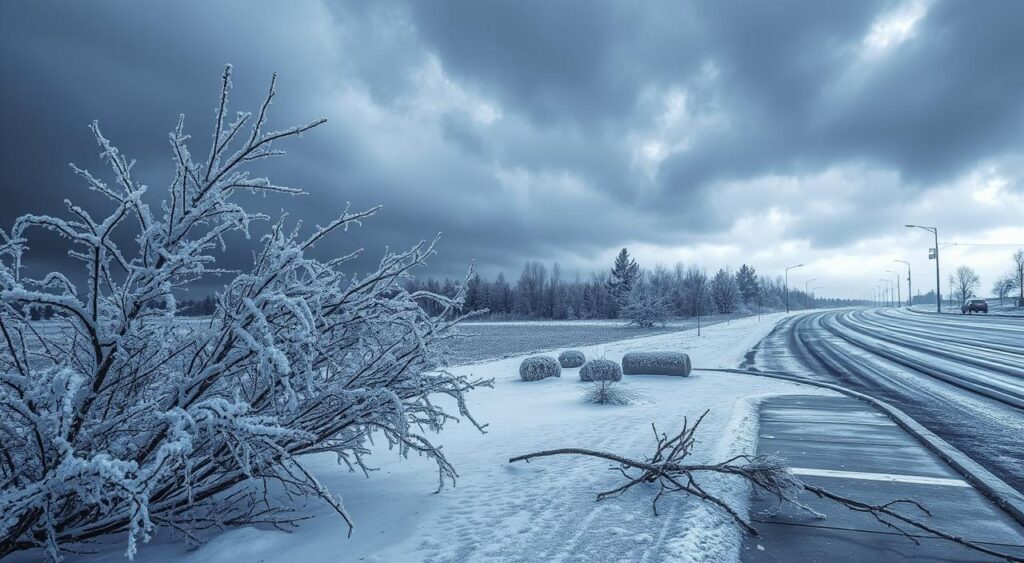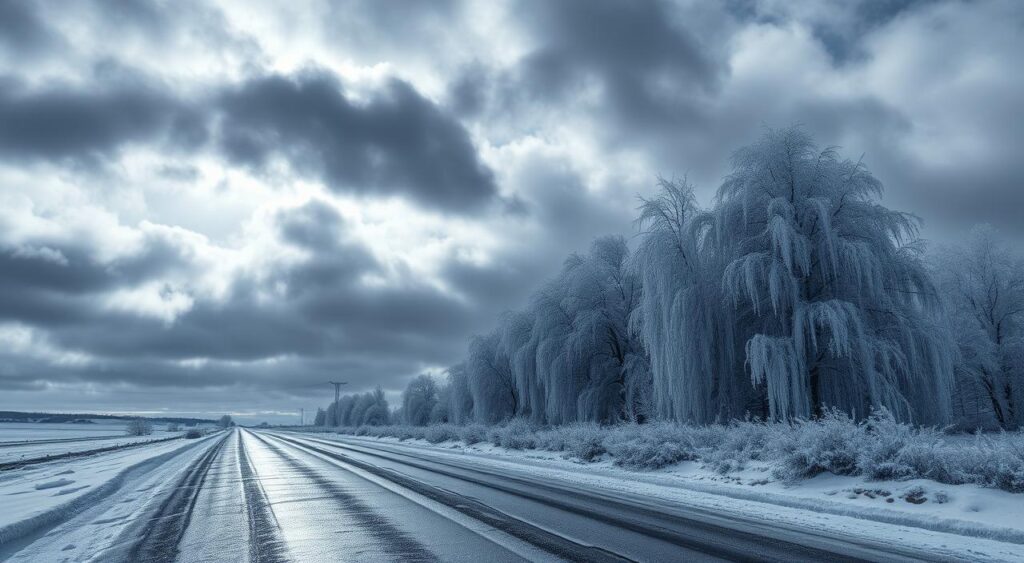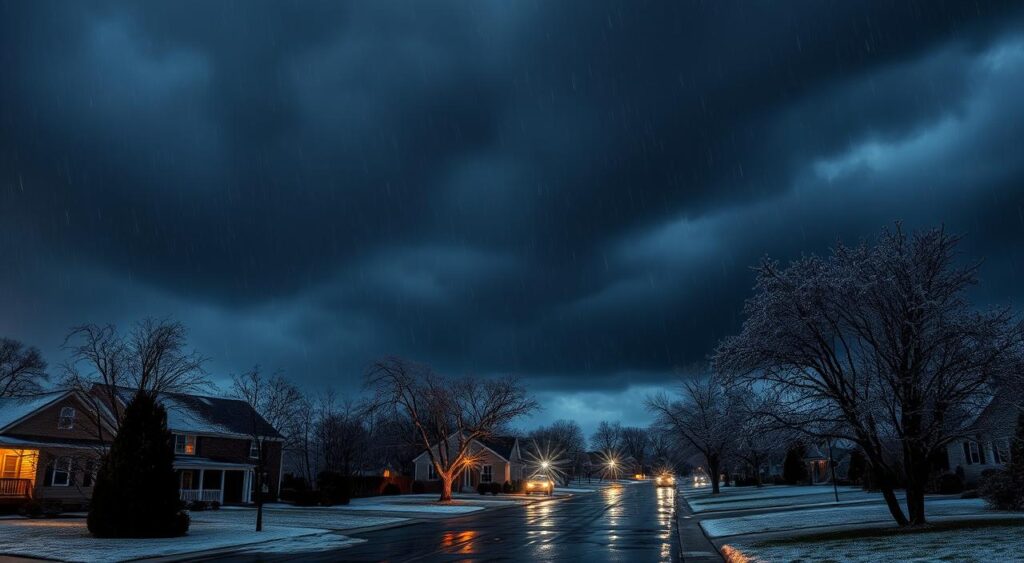Ice Rain Warnings: What You Need to Know to Stay Safe
It’s key to know about icy rain warnings and freezing rain advisories for safety. Ice rain makes roads slippery, posing a big risk to people and families. An ice rain warning is issued when freezing rain is forecasted. It’s vital to take steps to stay safe.
A weather alert for freezing rain is a must-read. It helps people get ready for the storm. By listening to these warnings, you can protect yourself and your family from ice rain dangers. It’s crucial to understand and act on icy rain warnings to stay safe.

It’s important to keep up with weather updates and take safety steps during ice storms. Knowing the risks of ice rain and acting early can help you avoid dangerous situations. This way, you can stay safe.
Key Takeaways
- Understanding icy rain warning and freezing rain advisory is crucial for public safety
- A weather alert for freezing rain is a critical notification that helps individuals prepare for the impending storm
- Heeding icy rain warnings can help prevent accidents and injuries
- Slippery road caution is essential during ice storms to prevent accidents
- Staying informed about the latest weather conditions is vital to ensure safety during ice storms
- Avertissement de pluie verglaçante, or ice rain warning, is a critical notification that requires immediate attention
- Freezing rain advisory can help individuals take necessary precautions to protect themselves and their loved ones
Understanding Ice Rain and Its Dangers
Ice rain, also known as freezing rain, happens when snowflakes melt into raindrops in warm air. Then, these raindrops freeze into ice when they hit cold air. This creates hazardous weather conditions. It’s especially dangerous because it makes roads icy and other areas hazardous.
To stay safe, follow freezing rain safety tips and watch for weather advisory warnings. These warnings tell you how long and how bad the ice rain will be. This helps you plan and get ready.

- Slippery surfaces, which can lead to falls and injuries
- Falling ice, which can cause damage to people, vehicles, and buildings
- Power outages, which can occur when ice accumulates on power lines and other infrastructure
Knowing about ice rain helps you protect yourself and your property. Stay tuned for more tips on how to prepare for and handle ice rain events.
| Weather Condition | Warning Level | Safety Tips |
|---|---|---|
| Freezing Rain | High | Avoid travel, stay indoors, and keep phone lines open |
| Icy Roads | Medium | Slow down, use low gear, and increase following distance |
| Winter Storm | Low | Stay informed, stock up on supplies, and have a backup plan |
Avertissement de Pluie Verglaçante: Breaking Down Weather Alerts
Understanding icy rainfall alert terms is key. A freezing rain warning is issued when freezing rain will disrupt daily life. It’s part of a winter storm warning system, alerting us to dangerous weather.
The weather forecast is crucial. It tells us when, where, and how bad the storm will be. Knowing about precipitation alerts helps us stay safe. For example, knowing about hazardous road conditions lets drivers plan better.

- Check the latest weather forecast for updates on the storm
- Have a winter emergency kit in your car for hazardous road conditions
- Stay informed about precipitation alerts to plan
Understanding freezing rain warnings and staying informed about winter storm warnings helps us stay safe. It’s all about being proactive during icy rainfall alert events.
How to Interpret Weather Warnings and Advisories
Understanding weather alerts is key to staying safe. An ice storm warning means freezing rain or drizzle will cause big problems. A winter weather advisory warns of conditions that will be a hassle but not as severe.
A hazardous weather forecast alerts you to potential dangers, like icy roads. It’s vital to keep up with weather alerts to get ready. Knowing the severity of each alert helps you stay safe.

Different Types of Ice-Related Alerts
- Ice storm warning: issued when freezing rain or drizzle is expected to cause significant disruptions
- Winter weather advisory: issued when winter weather conditions are expected to cause significant inconveniences
- Icy conditions alert: issued when icy conditions are expected to cause hazardous travel conditions
Stay informed about weather alerts to stay safe in icy conditions. Always check the latest weather alerts to know what’s coming.
Essential Indoor Safety Measures During Ice Storms
When a freezing rain forecast or ice storm alert is issued, it’s crucial to prioritize indoor safety. Stay informed about the winter precipitation alert and hazardous weather alert to take necessary precautions.
To stay safe indoors, consider the following measures:
- Keep emergency supplies, such as flashlights and first aid kits, easily accessible.
- Avoid using generators or grills indoors, as they can cause carbon monoxide poisoning.
- Keep phone lines open for emergency calls, and charge your devices in case of a power outage.
Be aware of icy conditions warning and take steps to prevent accidents. If you experience any damage to your home, contact a professional for assistance.

Stay safe, and stay informed. Ice storms can be unpredictable, but with the right precautions, you can weather the storm.
Protecting Your Home from Ice Rain Damage
When a severe weather forecast warns of an ice storm, it’s crucial to act fast. Icy conditions and snow and ice warnings mean you need to take immediate steps. This helps avoid damage from hazardous winter weather.
Preventing Ice Dam Formation
To stop ice dams, make sure your roof is clean of debris. Also, think about getting gutter guards. This stops water from freezing and damaging your roof and walls.
Protecting Pipes and Utilities
Keeping pipes from freezing is key during an ice storm. Wrap exposed pipes with insulation. Letting cold water drip from faucets can also help prevent pipes from bursting.

Having an emergency supply list is also vital. Include flashlights, first aid kits, and warm blankets. These are useful if you lose power or heat during the storm.
- Flashlights and extra batteries
- First aid kit
- Warm blankets and clothing
- Non-perishable food and water
By taking these steps, you can safeguard your home from ice rain damage. This ensures your safety during severe weather.
| Emergency Supply | Quantity |
|---|---|
| Flashlights | 2-3 |
| First aid kit | 1 |
| Warm blankets | 2-3 |
Safe Driving Techniques in Icy Conditions
When a severe weather advisory is issued, it’s crucial to take road safety precautions to avoid accidents. During an icy rain alert or winter storm alert, roads can become extremely hazardous. It’s important to be prepared and know how to drive safely.
To ensure weather emergency preparedness, consider the following road safety precautions:
- Slow down and leave plenty of space between vehicles
- Use low gear when driving uphill
- Avoid sudden movements, such as hard braking or acceleration
- Keep a safe distance from snowplows and other winter maintenance vehicles
It’s also important to be aware of the road conditions and weather forecast before embarking on a journey. If possible, postpone travel until the weather improves. Remember, safety should always be the top priority when driving in icy conditions.
Emergency Response Plans for Ice Events
When an icy precipitation alert is issued, it’s crucial to have a safety plan. A hazardous weather notice can be stressful, but a good emergency plan helps. Start by making a family communication plan. This should include emergency contact numbers and a meeting spot if you get lost.
For sleet or freezing rain alerts, being ready for power outages is key. Have a backup power source like a portable generator. Also, keep flashlights, batteries, and warm blankets ready. A first aid kit and a battery-powered radio are also important for staying updated.
Emergency Preparedness Checklist
- Flashlights and extra batteries
- First aid kit
- Warm blankets and clothing
- Non-perishable food and water
- Battery-powered radio and/or a NOAA Weather Radio
By following these steps, you can keep your family safe and warm during ice events. Always stay updated on weather and follow local instructions. With a solid emergency plan, you can face the storm confidently.
Recovery and Clean-up After an Ice Storm
After an ice storm, it’s crucial to be careful when checking for damage and starting the clean-up. A hazardous conditions alert might still be in place. Always follow severe weather advisory warnings to stay safe. Keep an eye on the latest winter storm update for road conditions and weather risks.
When going outside, watch for icy road caution and slippery conditions warning signs. These show where it’s easy to slip or fall. Wear warm, waterproof clothes and sturdy boots with good grip to prevent accidents.
- Check your property for ice or water damage on roofs, gutters, and downspouts
- Take photos and videos of damage for insurance
- Clear ice and snow from paths and driveways to avoid slips
- Look for and fix any broken or leaking pipes to stop water damage
Always put your safety and the safety of others first during recovery and clean-up. If you’re not sure what to do or need help, call local authorities or experts for advice.
| Task | Importance | Resources Needed |
|---|---|---|
| Assess property damage | High | Camera, flashlight, ladder |
| Clear ice and snow | Medium | Shovel, ice melt, sand |
| Document damage | High | Camera, phone, insurance information |
When to Seek Emergency Assistance
It’s important to know when to call for help during an ice rain event. A sleet warning or icy precipitation notice means the roads are dangerous. If you get a severe weather update, put your safety first.
When there’s a hazardous driving conditions notification, stay off the roads unless you have to go. If you do need to drive, make sure you’re ready for the winter weather alert. Take steps to keep yourself safe.
Here are some times when you should call for emergency help:
- Loss of heat or power during an ice storm
- Being outside in the cold, which can cause hypothermia
- Using generators or heaters the wrong way, which can lead to carbon monoxide poisoning
It’s always safer to be careful. If you’re not sure if you’re safe or if others are, call for help.
Keep up with the latest severe weather update and winter weather alert. This way, you’ll be ready for anything. By focusing on your safety and getting help when you need it, you can stay safe during an ice rain event.
| Emergency Situation | Action to Take |
|---|---|
| Loss of heat or power | Seek alternative heating sources or shelter |
| Exposure to cold temperatures | Seek medical attention if symptoms of hypothermia occur |
| Carbon monoxide poisoning | Evacuate the area and seek medical attention immediately |
Conclusion: Staying Prepared for Ice Rain Events
Frost warnings, icy precipitation advisories, and other emergency weather alerts are key to staying safe. They help us prepare for icy precipitation warnings and slippery road warnings. By listening to these alerts and taking action, we can protect ourselves and our loved ones.
Being informed and ready is the best way to handle winter storms. Watch the weather closely, know your local emergency plans, and have the right supplies. With the right steps, you can stay safe and strong against ice rain events.
FAQ
What is freezing rain and how is it different from other types of winter precipitation?
Freezing rain happens when rain falls through cold air near the ground. This causes the rain to freeze on contact with surfaces. It’s different from snow, which forms in the air, and sleet, which is snow that melts and then freezes again.
Why is freezing rain considered so dangerous?
Freezing rain is dangerous because it creates a layer of ice on roads and surfaces. This makes driving hazardous, can cause power outages, and damages buildings. It also leads to falling branches and power lines, posing a big risk to safety.
What do “avertissement de pluie verglaçante” or “freezing rain warnings” mean?
“Avertissement de pluie verglaçante” or “freezing rain warnings” are alerts from weather authorities. They warn of an impending freezing rain event. They give important details about when, how intense, and what to expect from the weather.
How can I interpret different types of ice-related weather alerts?
Ice-related weather alerts include warnings, watches, and advisories. Warnings mean hazardous conditions are imminent or happening now. You need to act fast. Watches indicate possible conditions, so prepare. Advisories signal less severe but still hazardous conditions, so be cautious.
What are some essential indoor safety measures to take during an ice storm?
Stay indoors as much as you can during an ice storm. Make sure you have a reliable heat source, like a fireplace or portable heater. Take steps to avoid carbon monoxide poisoning. Prepare for power outages by stocking up on flashlights, batteries, and a first-aid kit.
How can I protect my home from ice rain damage?
To protect your home, prevent ice dams on your roof and insulate pipes and utilities. Clear gutters and downspouts, insulate attics and crawl spaces. Consider installing heat cables to melt ice. Keep an emergency checklist with flashlights, batteries, and a backup heat source.
What are some safe driving techniques for icy conditions?
Slow down and increase your following distance when driving on ice. Avoid sudden braking or steering. If you start to skid, steer gently in the direction you want to go. It’s best to avoid driving in severe ice events to reduce accident risk.
How can I create an emergency response plan for ice events?
Create a family communication plan and prepare for power outages. Have emergency contact information ready. Discuss where to meet if separated, how to communicate, and what supplies you’ll need. Keep a list of emergency numbers and stay informed about local resources.
What should I do to recover and clean up after an ice storm?
Inspect your property for damage and document it for insurance. Be careful when clearing snow and ice, as falling branches or icy surfaces can be dangerous. If you need professional help, research reputable local companies. Focus on safety during clean-up and don’t hesitate to seek help if needed.
When should I seek emergency assistance during an ice event?
Seek emergency help if you or a loved one shows signs of hypothermia or carbon monoxide poisoning. Also, report significant damage or hazards to local authorities or emergency services immediately.
